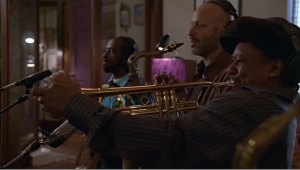Every artist in Treme is struggling. Creighton can’t finish his novel. Davis bounces from one job to another. Janette can’t afford to keep her restaurant open. Antoine shorts every cabbie he rides with. Street life is driving Annie and Sonny apart. And Albert can barely get a gang of Indians together. The most successful regular characters on the show – Toni and LaDonna – are not artists. LaDonna’s bar may have a blue tarp flapping over its roof, but it still does good business. And Toni’s a thriving lawyer.
(The one exception is Delmond Lambreaux, Albert’s son, a successful jazz trumpeter. He distances himself a great deal from his New Orleans heritage, even grousing about playing “Iko” to a Southern crowd in Episode 5, “Shame, Shame, Shame.” Has exiling himself from New Orleans made him more successful? Has it made his art less pure?)
Why is art such a struggle? Remember, art values the aesthetic over the utilitarian. Art deliberately avoids the utilitarian – the useful, the profitable, the merchandisable. You can make money off of art, but that’s largely out of your hands. If you want to make money, there are easier ways to do it.
If you want to live in this country at all, there are easier places to do it than in New Orleans, in fact.
What Treme reminds us – directly through Creighton Burnette’s YouTube rants; indirectly through the apathy of FEMA and the insurance agencies – is that, following Katrina, there was debate around whether or not to even rebuild New Orleans. “It’s below sea level,” observers noted. “The damage is so extensive. And another hurricane could come through again and cause just as much damage. Why bother?” It seemed like all of nature was conspiring to keep people out of New Orleans.
On a smaller scale, there are times throughout Season One where it feels like all of nature is conspiring to keep the protagonists from pursuing their art. Creighton struggles for inspiration. He doesn’t want to turn his novel about the 1927 flood into an allegory for the current catastrophe. But his anger at the nation’s indifference to New Orleans’ suffering is too raw to set aside. Antoine can barely afford to make it to the few gigs he gets. His trombone gets confiscated during his arrest (Ep 03, “Right Place, Wrong Time”), putting him in dire straits. Janette can’t keep her gas lines clear enough to serve the crowds she gets. She can’t pay for repairs, food, rent and her staff’s wages at the same time. As Episode 9 (“Wish Someone Would Care”) draws to a close, she’s considering moving to New York – the same place Delmond went – to make a living there.
New Orleans is a tough place to live. The artist’s life is a tough one to live. The devastation of the broken levees made both of those harder.

So, in the first season after the storm, how do our artists do?
Antoine keeps living his hand-to-mouth life. His circumstance vary with his luck and with the quality of his choices. He’s got a good woman and a few regular gigs. But he’s too trifling to visit Baton Rouge and his children as often as he should. He fools around on his live-in girlfriend. And when he gets a plum gig with the legend Alan Toussaint, he gambles most of his gig money away. Antoine is the same kind of comic relief fuck-up that Simon, Mills and Overmyer frame so many of their stories around. Antoine will manage, because New Orleans is the only kind of city that can sustain him.
Albert gets to march with his gang on St. Joseph Night. Delmond conspires with the rest of the tribe to break down some of last year’s suits for re-use. Albert grouses about incorporating pieces of an old suit – sacrilege to a Mardi Gras Indian – but doesn’t put up a fight. That’s about as far as we’ll see Albert go toward compromising. As a result, we get to watch the tribe march: meeting other tribes and showboating for passerby.
(The threatened confrontation with the police passes without much of a ripple)
Janette concedes that the city’s too much for her. She packs it in to move to New York City. Davis tries to tempt her with one last parade of delights through New Orleans, but she’s already bought her tickets. This is a good thing, aesthetically. If Davis’s attempts to woo Janette back to New Orleans had succeeded, that’d be far too Aaron Sorkin or Joss Whedon for a show as naturalistic as Treme.
Sonny and Annie go their separate ways. Annie is and always has been the more talented of the two and Sonny knows it. He smashes his keyboard – his only means of making money – in a temper tantrum when he realizes she’s not coming back. Meanwhile, Annie shacks up with Davis, a relationship I predict will linger into the second season. We see potential for her future: helping another street musician (played by a slumming Steve Earle) write music. Maybe she’ll find her voice yet.
And Creighton? That one’s hard.

I have a hard time with the writers’ decision to kill off Creighton. Sure, everything he loved about New Orleans was fading. He displayed the classic symptoms of depression: loss of appetite, inability to concentrate, loss of interest in earlier passions. He couldn’t finish his novel. He was worried about money. But suicide’s such a self-centered act. It’s an obsession with one’s own suffering that drowns out all else. And Creighton had to know how his death would affect Toni and Sofia. He clearly loves them. Did he think they’d be happy he was gone? Nothing in his character shows that.
Fortunately, Treme does not shy away from showing how hard Creighton’s death hits his family. The bewilderment, grief and anger play out in their proper course.
“There are so many beautiful moments here.”
“They’re just moments. They’re not a life.”
– Davis McAlary and Janette Desautel, Treme, “Wish Someone Would Care”
Season One of Treme ends with a second line march for Daymon Brooks’s funeral. Antoine marches but doesn’t play, though he could probably use the money. Toni marches, reaching a new level of acceptance for her husband’s death and his final wishes. And LaDonna kicks loose as the band gets into swing, strutting and waving with the best of them. The rest of the country wonders how New Orleans can dance when it hurts so bad. They don’t understand that that’s why you dance.
The second line ends outside church. The marchers circle up and finish their song with a rousing cheer. Then, the music is over. Antoine carries out an argument with a cabbie he stiffed. People talk about their plans for the rest of the day. Car doors slam; engines start. Life goes on.
By choosing to end on that note, not on the second line finishing, Treme delivers its message. There is Art and there is Life. Real Art – like the art created by the residents of Faubourg Treme every day, rain or shine – fills Life with a series of beautiful moments. But Life doesn’t go away.


Great post, but this is a level of scrutiny that this show does deserve. It’s amazing.
This show, together with your beautiful Overthinking It (although many have already pointed out that it is not in fact “over” thinking it in Treme’s case), gives me the chills.
Treme started *really* slow, and to be honest, I wasn’t really eager to watch the first episodes or so (not as eager as I was to watch the next The Wire episode, at least).
But after episode 04 or so, I could adjust to the rhythm and from then on, I really enjoyed it. It took a while to really get what the show is about. You framed it in a way that it’s about art vs. life, and although I wouldn’t have used these terms, this is exactly how I “got it” on a gut feeling level and from then on, I started enjoying the show.
So, I guess there’s only two things left: Waiting for season 2 and planning a trip to New Orleans…
Thanks people!
That’s actually one of the things I struggled with – there’s not a lot to overthink about Treme. If you watch it on a superficial level, looking for plot twists and tearjerking revelations, you’ll be disappointed. Or maybe Mlawski’s just better at this sort of thing.
I think the show is definitely about art, but even more so about the culture and tradition from which it emanates. Simon has said in interviews and such that Treme is intended to highlight New Orleans as a symbol of America’s true and lasting achievements in culture (a more optimistic look at America it seems). Naturally, by neglecting New Orleans in its time of need, FEMA and the feds fail to nurture a city so emblematic of America’s cultural contributions. Some more expected anti-institutionalism right there. Anyways, awesome article!